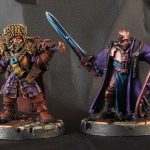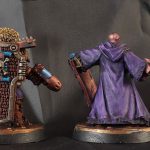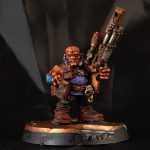In our How to Paint Everything series, we take a look at how to paint different models, armies, and materials, the lore and science behind them, and different approaches to painting them. In this article, we’re exploring how to paint inquisitors, the Imperial agents tasked with investigating and wiping out threats to the Imperium.
Who Are the Inquisition?
The Inquisition are a secretive Imperial institution tasked with protecting the Imperium from threats of all kinds. Part spy, part detective, part brutal enforcer, Inquisitors travel the Imperium investigating and rooting out threats to its existence and eliminating those threats with brutal force. Inquisitors have almost carte blanche to operate in the Imperium, able to bring the full might of its resources to bear when the threat requires. Originally founded by Malcador the Sigilite on the orders of the Emperor to find a group of people who could root out enemies to the Imperium both within and without, the Inquisition is split into three groups, each dedicated to wiping out a different threat to humanity:
- The Ordo Xenos are dedicated to rooting out alien threats, frequently dealing with the likes of Genestealer Cult uprisings, perfidious Eldar, and other dangerous alien threats. The order militant of the Ordo Xenos are the space marines of the Deathwatch, elite marines chosen from other chapters and trained to deal specifically with Xenos threats.
- The Ordo Malleus are dedicated to rooting out the taint of Chaos and destroying the foul creatures of the warp when they spawn in realspace. Their never-ending quest sees them taking on Chaos incursions and insidious cults and working with their order militant, the space marines of the Grey Knights, elite psychic marines trained to deal specifically with daemons.
- The Ordo Hereticus are dedicated to rooting out and fighting threats from within, from humans who might forsake the Emperor. Their main focus is rooting out and putting an end to treason and apostasy, fighting unchecked mutation, and destroying unsanctioned or rogue psykers. Their order militant is the Adepta Sororitas, the Sisters of Battle.
Although the Inquisition is focused on destroying threats to the Imperium with fanatical zeal, the organization and its members are by no means a monolith; Inquisitors come from different backgrounds and have many different ideas about the nature of their mission and how to best go about fighting for the cause. Inquisitors tend to fall on an ideological scale between Puritan and Radical, depending on how they view the threat and what they consider to be appropriate means of fighting against it. Puritan Inquisitors tend to be very hardline, black-and-white moralists about their work, with little or room for nuance or understanding. Radical Inquisitors on the other hand seek to understand the threat and may even use it to combat the thing itself, turning the enemy’s own weapons and methods against them. For a Puritan Xenos Inquisitor, doing anything with captured alien technology besides destroying it might be considered dangerous while a Radical Xenos Inquisitor may work directly with Xenos allies and mercenaries. A radical Malleus Inquisitor might use chaos artefacts and spells or daemonhosts to fight chaos threats while a Puritan would consider this to be dangerous heresy. These differences often mean that the agents of the Imperium disagree on the best course of action and they may frequently come up against each other.
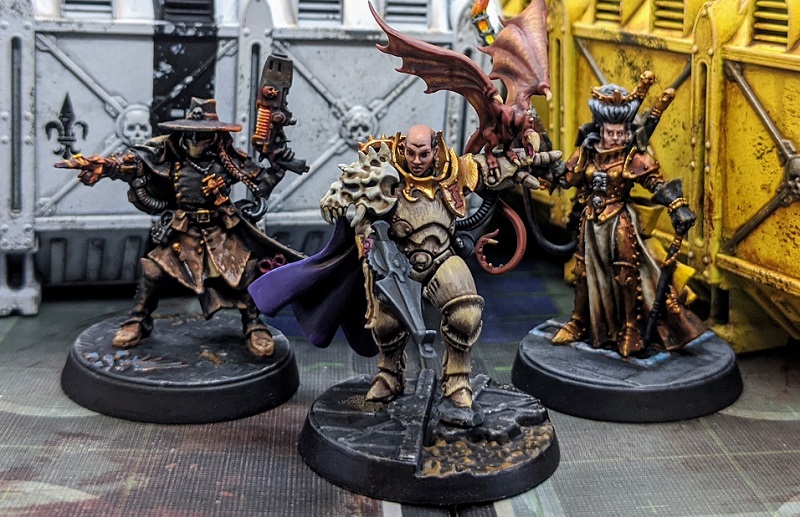
Where to Read More
If you’re looking to read more about Inquisitors you’re in luck—as the “super spies” of the Imperium, Inquisitors offer more editorial freedom than perhaps any other characters in the 40k setting, and have had a ton of great books written about them. The most notable of these are the three books in the Eisenhorn Trilogy by Dan Abnett, which follow Inquisitor Gregor Eisenhorn through his slow descent into radicalism as he struggles to keep the Imperium safe from dangerous threats. These are widely considered to be the entry point for 40k novels (though in my opinion the second one is fairly mediocre), and are reportedly getting adapted into a TV show. If you like those, there’s also the Ravenor books, which follow an inquisitor introduced in the Eisenhorn trilogy and chronicle his adventures. If you’re looking for something more recent, Chris Wraight’s Vaults of Terra: The Carrion Throne follows Ordo Hereticus Inquisitor Erasmus Cowl investigating a shadowy conspiracy that seems him and his retinue hunted by xenos, heretics, and other inquisitors. And for a deep dive into the Inquisition itself, check out John French’s The Horusian Wars series, which follows Inquisitor Covenant and explores the conflicting ideologies within the Inquisition.
Playing Inquisitors
With the new changes to how detachments work in 9e, along with the addition of the Agent of the Imperium rule, a lot more inquisitors are likely to be hitting the battlefields of the 41st (or 42nd, depending which sect of the Ordo Chronos you’ve sided with) millennium. Here at goonhammer we think that’s pretty awesome. Inquisitors are some of the most interesting and fun to paint models Games Workshop has come out with, and we’re here to help you do it. We recently covered how Inquisitors work in our Faction Focus: Agents of the Imperium and Pariah review articles.
Painting Inquisitors
Every inquisitor is a unique champion of the Imperium, whose appearance is colored by their personality, means, and methods. They draw on resources unthinkable to most citizens, and even many planetary governors. Given their individuality, I can’t tell you how to paint YOUR inquisitor, but I can arm you with some basic principles to help you end up with something awesome and unique.
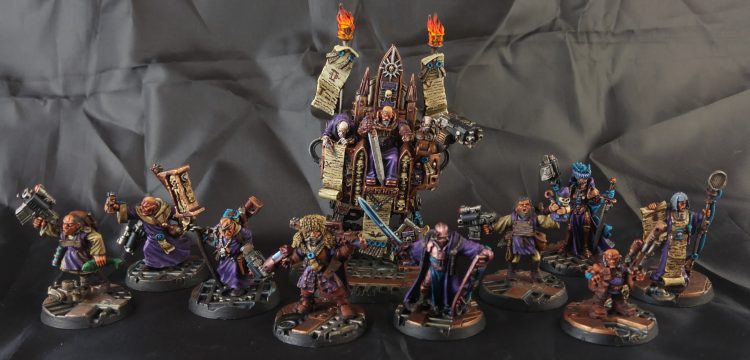
Given that, the first principle should be obvious. Each inquisitor is a Singular Individual. Occasionally an inquisitor’s dress will mirror the force they accompany, but even then, that uniformity should be an expression of their personality. More often, an inquisitor’s regalia will be unique to them.
When deciding on your paint scheme, it’s important to consider who they are and how they operate. A palette of moody, dark tones might be appropriate to a radical inquisitor who lurks in the darkest shadows of the Imperium, but a brash monodominant from the Ordo Malleus who sprays blessed bolt shells first and asks questions later is more likely to favor bright silvers, golds, and reds.
The other thing to remember when painting your inquisitor is that you only need to paint one of them. They don’t need to fit in with an existing force, so they’re an excellent place to try out new colors and techniques. If things go a little pear shaped with a new technique, it’s also MUCH easier to salvage a paint job that doesn’t need to blend in seamlessly. A few happy accidents from experimenting might even lend an extra mysterious and spooky air to your model.
That brings us to our next principle. You shouldn’t be afraid to Get Weird. Nobody tells an inquisitor what to wear. A large chunk of them are half mad. An overlapping, but not identical large chunk are pretty into heresy themselves. This is the time to try out OSL or attempt a creepy, mottled skin tone or mystical tattoos. Tie it into the backstory and personality of your inquisitor and go wild.
The first two principles I think apply to every inquisitor. The next two are just strong suggestions. With that out of the way, I’d like to suggest you Use Color, Sparingly. A palette of mostly neutral tones with a single strong color is a pretty surefire route to a striking color scheme. Considering the moody, noir nature of a lot of inquisitors, they take to this especially well. On the most extreme case, you could go with something that almost looks like it steps out of Sin City. This would probably look good, but your neutral tones don’t have to be black and white. Black, Soft White, Grey, Cream, Brown, or any desaturated color can work well. Your striking color can be a single color, or a range of related tones, such as bright, saturated gold paired with yellow or saturated, warm tones.
The last principle I like to consider when painting an inquisitor is Light and Shadow. While not a necessary component, it’s something I think you should always consider when deciding on the paint scheme for your inquisitor. Inquisitors are creatures of contrast. They stand sentinel at the border between the Emperor’s light and the darkness of damnation. They uphold the purity of man, but are often sullied by the dirtiest of methods. It is only fitting this be reflected in their appearance. While this can take the form of OSL, the more general approach I take is to really push the shadows deep, dark, and moody, while ensuring the light shines through in the highlights.
Case Study – The Aristocrat
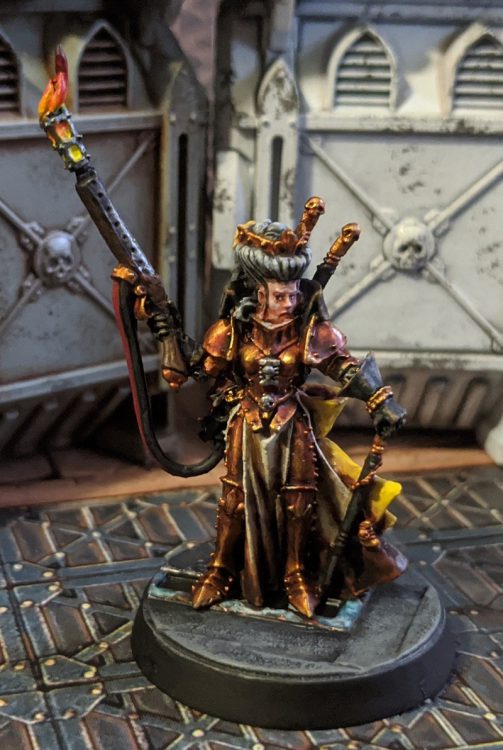

The easiest way to explore the process of painting an inquisitor is through a model. I’m mostly going to talk through rationale on this model, and append the paint recipes at the end.
This is one of the ancient inquisition sculpts that came out with the original witch hunters codex, and probably one of my favorite models GW has ever produced. It’s out of production, but I managed to through made to order. It’s a touch small by modern standards, and there’s a few spots that are slightly iffy, but like many of that batch of models, it exudes character. At least to me, the direction to go with this model was pretty obvious from the start.
With her massive hair and baroque armor, this isn’t someone who stalks the gutters. She blends in flawlessly among the upper crust of the Imperium, rooting out decadent cults and traitorous schemes among the nobility. Her equipment is worn and weathered, but impeccably looked after. Appearances must be maintained, even when battling cultists in the wreckage of a grand ballroom.
Her robes and armor were the first parts of the color scheme I nailed down. I really wanted to do a deeply shaded gold armor, as well as try out some glazing to do the transition on the robes. The wig screamed powdered to me, so I decided on grey for that. A pale skin tone seemed appropriate for a noble spending most of her time indoors and and was fairly convenient for making the face a focal point. From there, the main color to decide on was the bow. As the warm, gold armor was so dominant on the model, I didn’t want to clash with that. I considered red, but it was a bit stereotypical. I think the yellow worked out well, harmonizing with the other colors, being appropriately attention grabbing for a noble, and also lending a slightly more delicate and feminine look to the entire composition.
Paint Recipes:
- Gold: Retributor Armor with one coat of Guilliman Flesh all over, followed by successive, targeted washes of Reikland Fleshshade in the recesses to deepen the shadows.
- Robes: Several Coats of VMA Sand(Ivory) to achieve a uniform color, followed by an overall wash of Agrax Earthshade. I applied many successive glazes of Agrax, covering less and less of the tabard each time to achieve a smooth transition. At the end of the process I touched up a few places at the bottom of that were still a bit too light with VMA Burnt Umber.
- Hair: I completely forget what greys I used for this, but I painted the entirety of the hair with a mid-grey, washed with Nuln Oil, rehighlighted with mid grey, then worked up with white added to the grey for highlights.
- Yellow: Several thin coats of VMC Yellow Ochre to achieve a smooth finish, followed by Reikland Fleshshade. A highlight of Yellow Ochre mixed with VMC Deep Yellow was used to tidy up the shades, then several glazes of Deep Yellow were used to highlight. The yellow is transparent enough to work as a glaze with normal amounts of water to thin it.
- Leather: VMC Black, highlighted with Skavenblight Dinge and Gorthor Brown, and shaded with Nuln Oil.
- Flame: Painted white, then covered with thinned VMC Deep Yellow, followed by VGC Flame Orange and Evil Suns Scarlet further and further up the flame. I didn’t let everything dry, so they blended together slightly. Finally, after they had dried completely, I added some thin black paint to the tip to give it a smokey look.
- Steel: Vallejo Mecha Air Dark Steel, Shaded with Nuln Oil, then sparingly highlighted with Vallejo Mecha Air Steel. The blackening on the inferno pistol was achieved with several washes of Nuln Oil.
Case Study – The Stranger
Now let’s look at the process from a different perspective, starting from an unpainted model and walking through the rationale and steps.
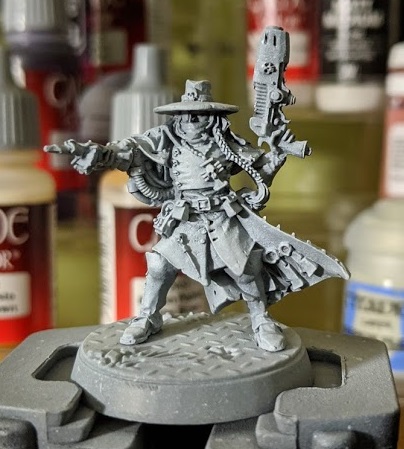
This model is an old limited edition model games day model I managed to pick up. (A similar model is still available from GW here, despite the sculpt being old enough to vote.) I’ve zenitally primed the model to help me take stock of everything, but don’t despair if you lack an airbrush, this isn’t one of those tutorials.
While this model was originally meant to represent Gideon Lorr, a puritanical witch burner, this model speaks to me. On a deep, spiritual level. It whispers grungy tales stalking mutant gangs in the underhive. Tales of dangerous alleys and dodgy characters. This guy doesn’t operate in the open, and his equipment is battered and well worn.
Eventually I settled on a scene to base my paint choices around. He’s the man sitting broodingly in the corner of an underhive dive bar. Everyone knows he’s trouble and keeps their distance, but nobody really knows how much trouble until a plasma bolt blows off the cult-leader’s head and storm troopers start rappelling in through the abruptly installed skylights.
Pursuant of this, I decided a few things. Apart from his rosarius, which I assume he usually keeps tucked away and hidden, I wanted to mostly avoid gold. Attention grabbing bling is not his thing. Second, I wanted to keep all of his attire very muted and worn, sticking to mostly dark, earthy colors. There’s nothing clean about him, and I wanted the color palette to reflect that.
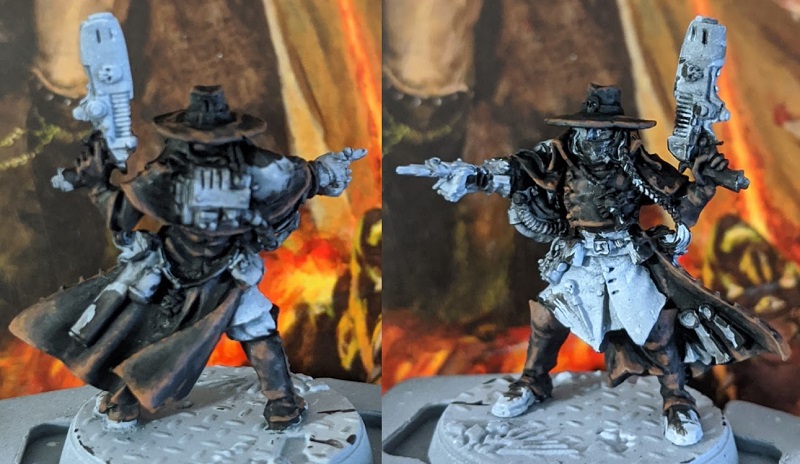
I began with the color that would be the biggest area on the model, his coat. There really wasn’t any question in my mind what color this dude’s trench coat would be. (Technically it’s a weird cross between an Iverness coat and a napoleonic cutaway dress coat. Don’t @ me.) It had to be black. I also made his hat, gaiters (boot covers), and gloves black, to carry the same color across the model while leaving some separation between them to avoid it becoming an entire field of black. At this point it’s basically the exact method for worn black leather I went over in this article. I will summarize here:
- Basecoat VMC Black
- Progressive mixes of Black and Skavenblight Dinge, then with Skavenblight and Gorthor Brown, highlighting with dots, interrupted lines and scratches, concentrating on areas of the most wear.
- Wash of Nuln Oil
- Rehighlight in a similar manner with Gorthor Brown
- Mix in more and more Jokaero Orange to the Gorthor Brown for a few layers of smaller and smaller highlights, and pure Jokaero Orange highlighting the corners and absolutely most battered spots.
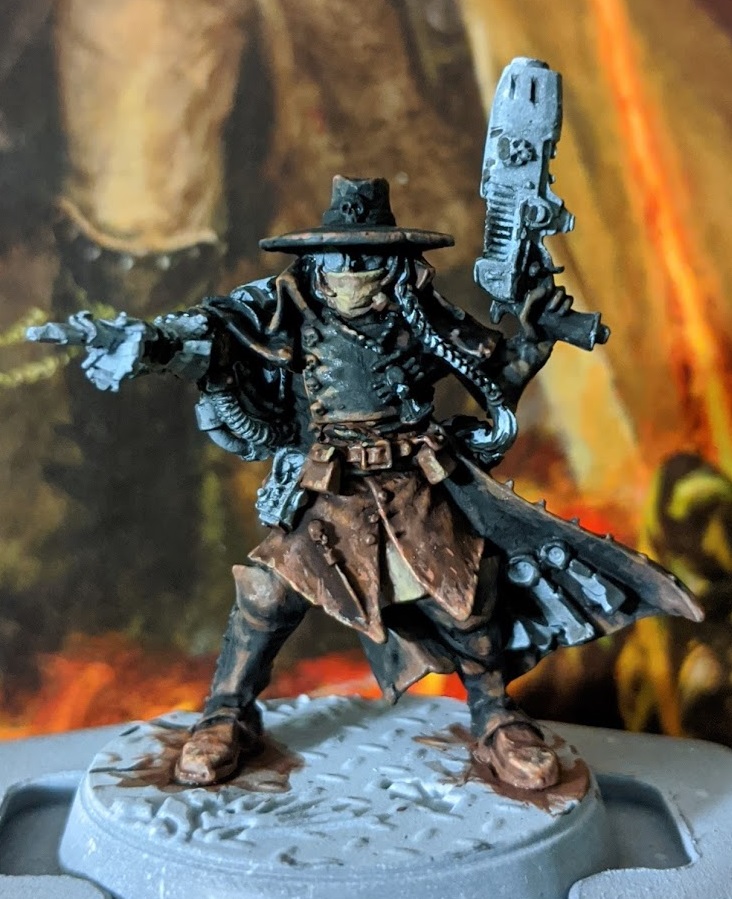
For the brown leather I used a similar process to the first, but dove into something I only briefly mentioned in the leather article. Using flesh tone paints as highlights. This gives a particularly scuffed, battered appearance, which I think fits well here:
- Basecoat Gorthor Brown
- Highlight with mixes of Jokaero Orange and Gorthor Brown
- Wash of Agrax Earthshade
- Highlight of Jokaero Orange, followed by P3 Khardic Flesh and then VMC Dark Flesh
I also touched a few corners of the black with Khardic flesh to help define edges where needed.
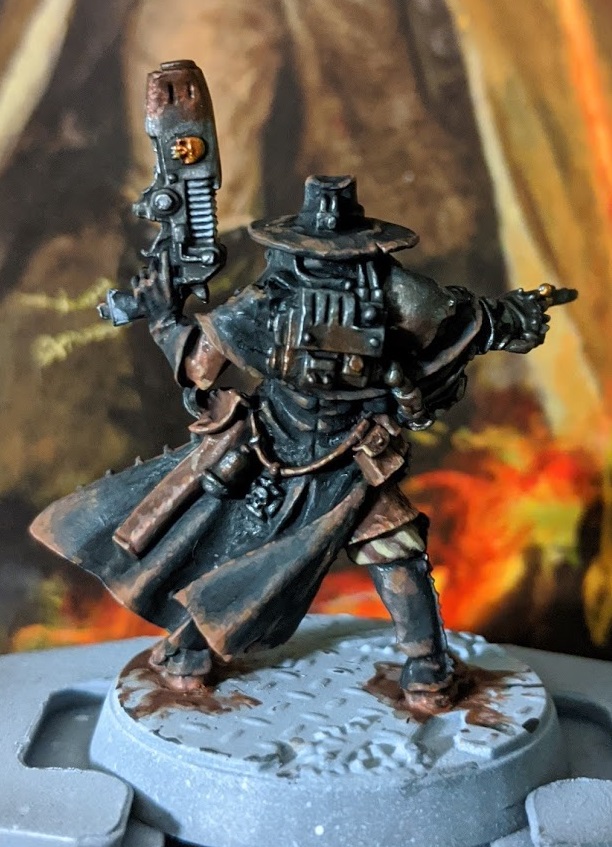
His undertunic was painted a light tan. This was accomplished with a basecoat of Gorthor Brown and highlighted with mixes of Gorthor and VMC Dark Sand until it reached a level of brightness I liked. In the back view, note that I painted his elbow as brown leather. Mantled coats are frequently sleeveless, and painting it in a different color allowed me to break up the black and separate his glove the main body of his coat.
The steel is a basic recipe:
- Vallejo Mecha Air Dark Steel basecoat
- Nuln Oil wash
- Vallejo Mecha Air Steel on sporadic highlights, rather than solid edge highlights, to lend the metal a more battered and scratched appearance
- Agrax Earthshade applied selectively to a few recesses and the undersides of some areas, to really grunge him up a bit. The tip of his plasma pistol was subsequently hit with a little more nuln oil to give it a more charred look (not shown in this picture)
The little touches of Gold are also simple. It’s not a focus, so I just painted then in Retributor Armor then washed with Reikland Fleshshade to dull them down.
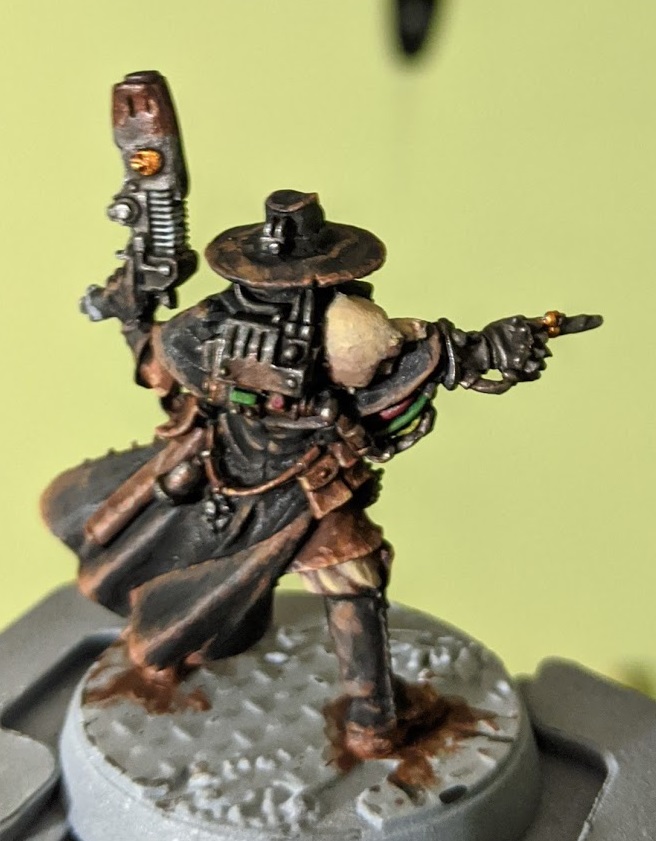
At this point, most of the colors were on the model and I was able to step back and take stock. In general I liked how it was turning out, but his shoulders were a bit too monotone for my tastes, and the complete lack of color was a bit too much. To tackle both problems, I first used the same colors (Gorthor Brown and VMC Dark Sand) that I used on his tunic and pants to paint his shoulder armor. It helps a great deal to use a wet palette for this process, which lets you mix a gradient of colors as you highlight, so you can easily go back and touch up the gradient. Getting a fairly smooth, painterly gradient like this is extremely easy and fits a weathered model quite well. I also hit his headband with the same colors as I’d forgotten it earlier.
I went in over the wires which had been painted steel to add some color. I watered down VMA Gory Red, VGA Moon Yellow, and VGC Fluo Green. As all of these paints are fairly transparent, just glazing one or two coats over the steel color was enough to quickly color the wires without much work.
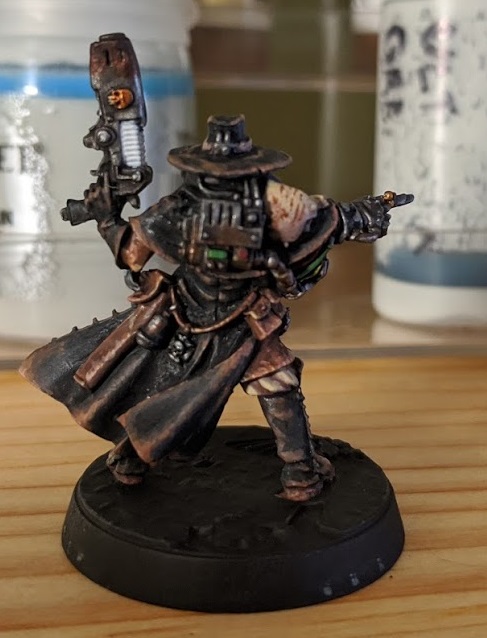
His shoulder was still looking a little bit plain. I dug out my detail brush and VMA Burnt Umber. As it’s slightly transparent it works well for text that won’t stand out too much. I vaguely blocked in a triangle I thought vaguely resembled an aquila and a few lines of text. It helps to still have the color gradient from painting the base color still mixed on a wet palette to touch up with. I figure this little text is a blessing or prayer. A hint at who he might be, but nothing that would mark him out too much from the average imperial citizen.

Now we get to the color I was talking about. I wanted to make both his plasma pistol and ring look as if they were glowing. I’d never done OSL before, but luckily I was able to find a cool guide on some random website. While I didn’t follow it word for word, it was really helpful in coming up with a method using the paints I had on hand. I painted his hand first, because if I screwed up, repainting a steel gauntlet was going to be a lot faster than fixing up the entire side of the model. The process I ended up using was as follows:
- Highlight using VMC White on some of the ring and some of the edges facing the ring. (Not Pictured)
- Wash with watered down VGA Gory Red
- Rehighlight a few edges with white, focusing closer to the edge and nearer the glowing ring
- Wash with VGC Orange Fire
- Repeat white highlight, only directly on the ring and the very edges nearby.
- Wash with Golden High Flow Acrylics Hansa Yellow Medium
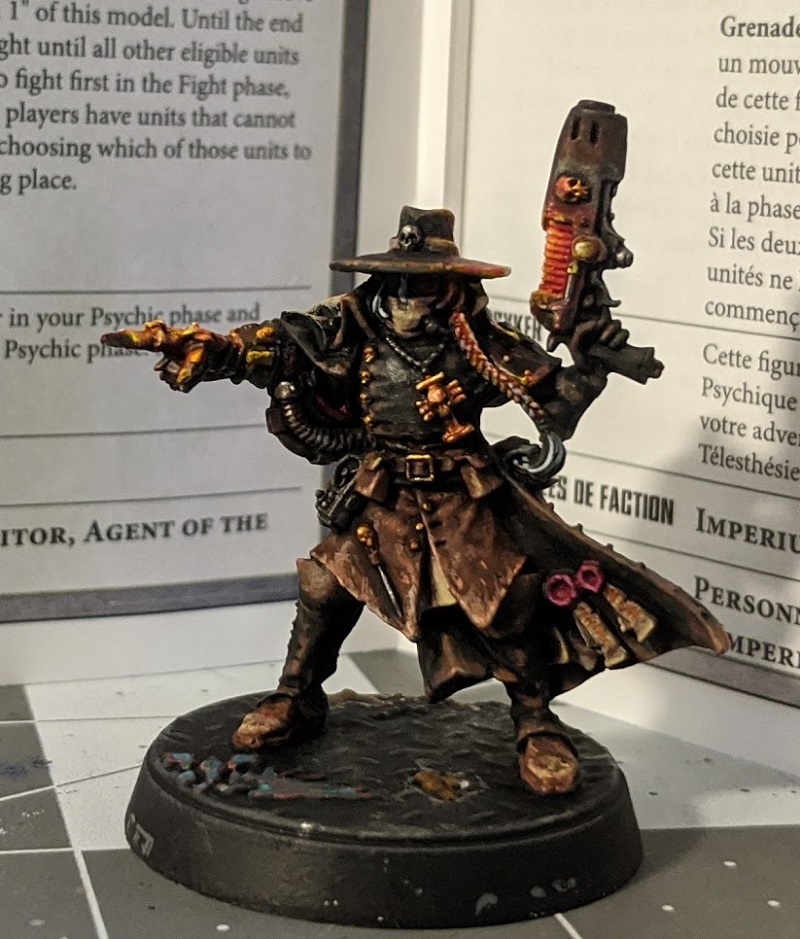
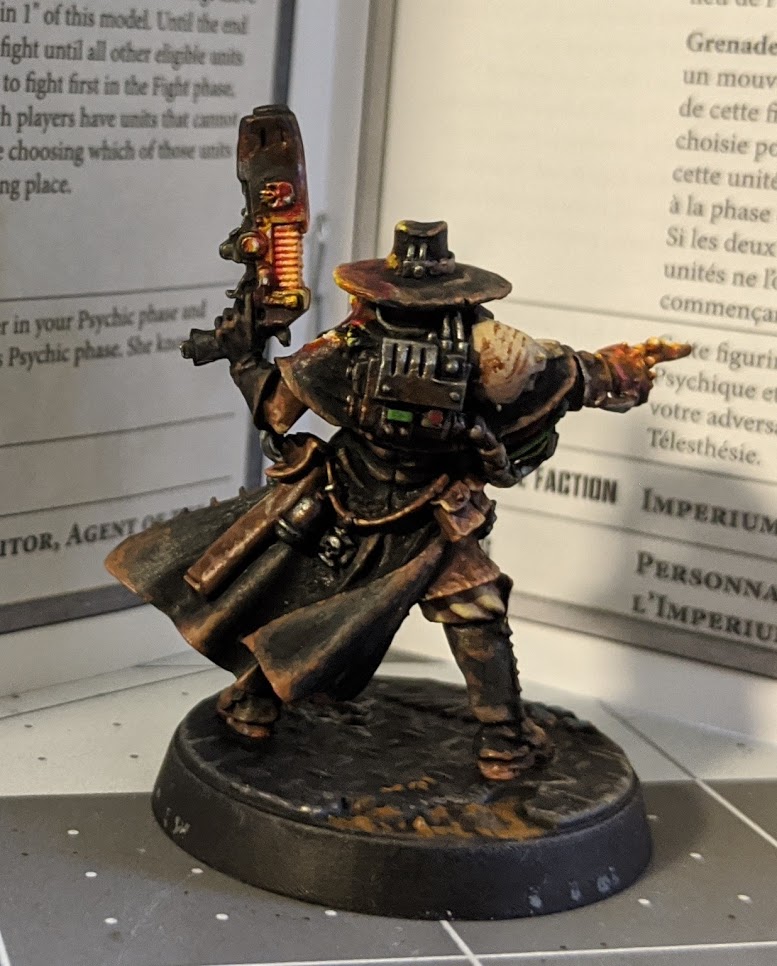
As I hadn’t ruined his hand too bad, I repeated the same steps on the plasma pistol (Basecoating the entire coil white before starting). And… I didn’t quite like it. It wasn’t bad, but it wasn’t great, and didn’t immediately sell the effect quite as much as I wanted. So I stepped back, snapped some pictures, and took a break. I shared the pictures on discord, and got some great feedback. SALynne as well as RichyP, the author of the article I linked above gave me some great advice. Armed with that, I got to salvaging the effect.
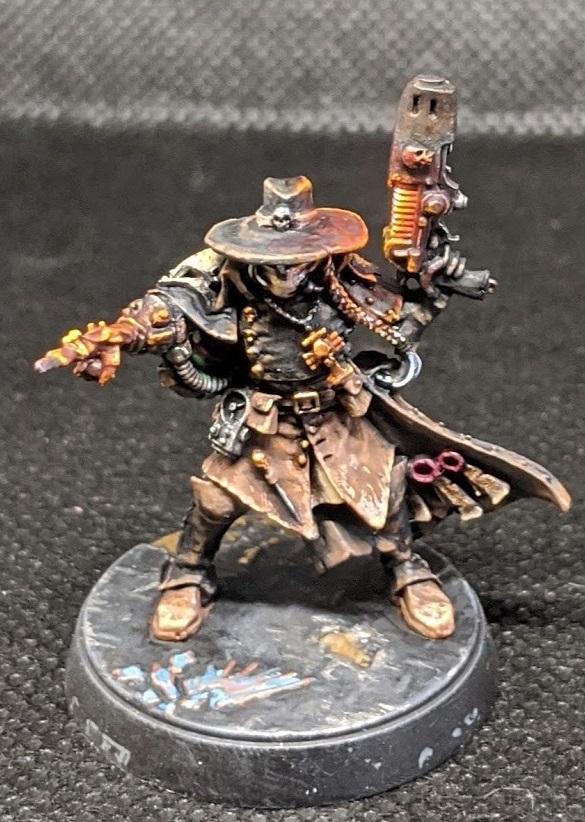
Luckily I had picked up some Carroburg Crimson which is absolutely amazing for painting red OSL. Part of the issue I had was that I was missing the deep, colored shadows that really sell that the area is being bathed in clowing light. A few washes with Carroburg helped that amazingly. I also punched up a couple spots closer to the light sources and highlighted the very peaks of the glowing areas with pure white. In the end, I got an effect I am much happier with. The flexibility of only having to paint a single model makes it much easier to experiment and fine tune techniques you’re trying for the first time, and inquisitors are great for that!
Before the final images, I’ll quickly go over the colors used on the few bits I didn’t go over
- Purity Seals: VMC Burnt Red mixed with VGC Warlord Purple for the wax, then mixed with a little bit of white to dot highlights around the edges. VMC Dark Sand washed with Agrax Earthshade and rehighlighted with dark sand for the parchment, and VMA Burnt Umber for the faint lines indicating lettering.
- Hair: VGC Wolf Grey Washed with Nuln Oil, then highlighted with Wolf Grey and with a final bit of Ulthuan Grey at the peaks.
- Skin: P3 Khardic Flesh, washed with Reikland Fleshshade, then rehighlighted with Khardic Flesh mixed with a touch of white.
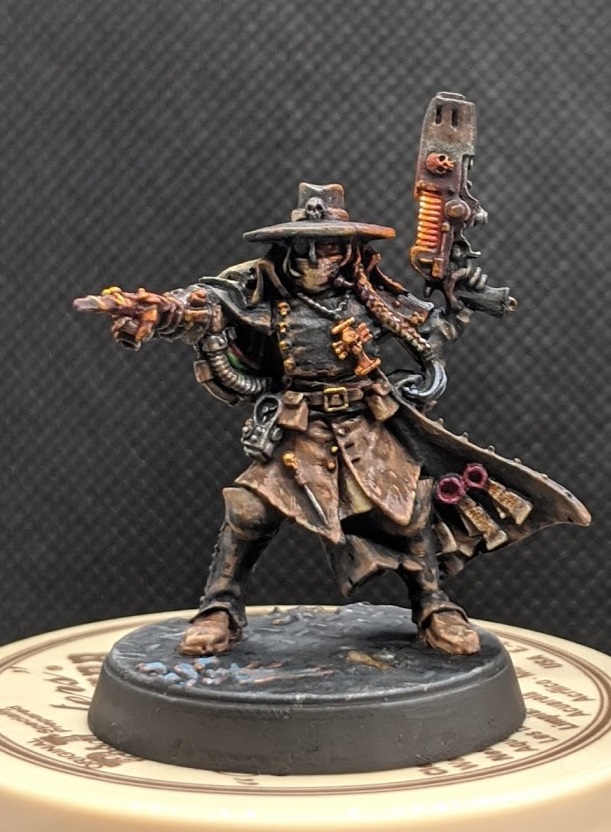
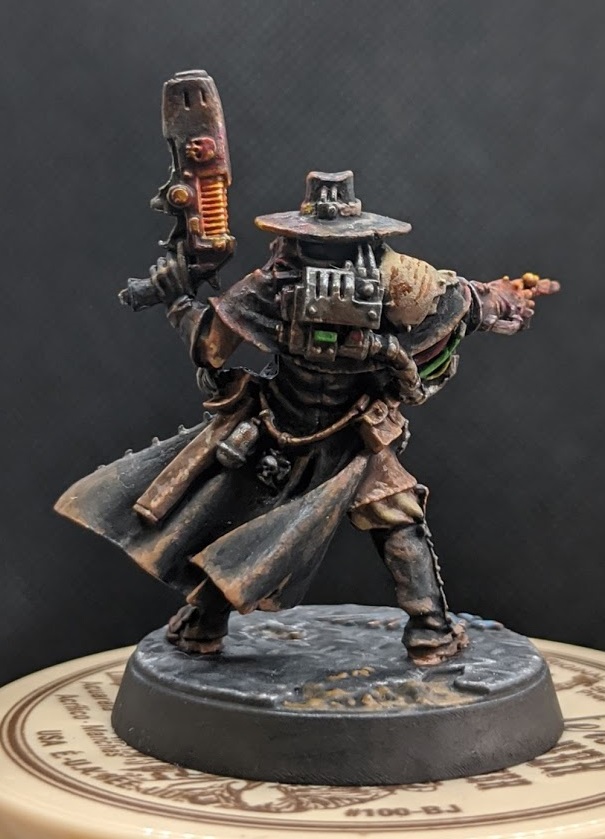
Inquisitor Kyria Draxus
Finally, let’s paint a named inquisitor. When I saw Draxus teased, I instantly thought she was an amazing sculpt that the paint scheme didn’t quite live up to, and I’ve wanted to take a crack at it myself ever since. The official paint scheme takes a lot of inspiration from dark eldar for her armor, but I wanted to lean a bit more into the eldar side and really push the depth and contrast of the model with a wraithbone look. (Or what fellow goonhammer contributor Genola has termed ‘Wraithaboo’)

First a quick word about subassemblies. If I were to do this again, I would probably have painted her shiruken catapult arm separately, but I consider painting heads and backpacks separately pretty essential to be able to get good results in all the crevices.
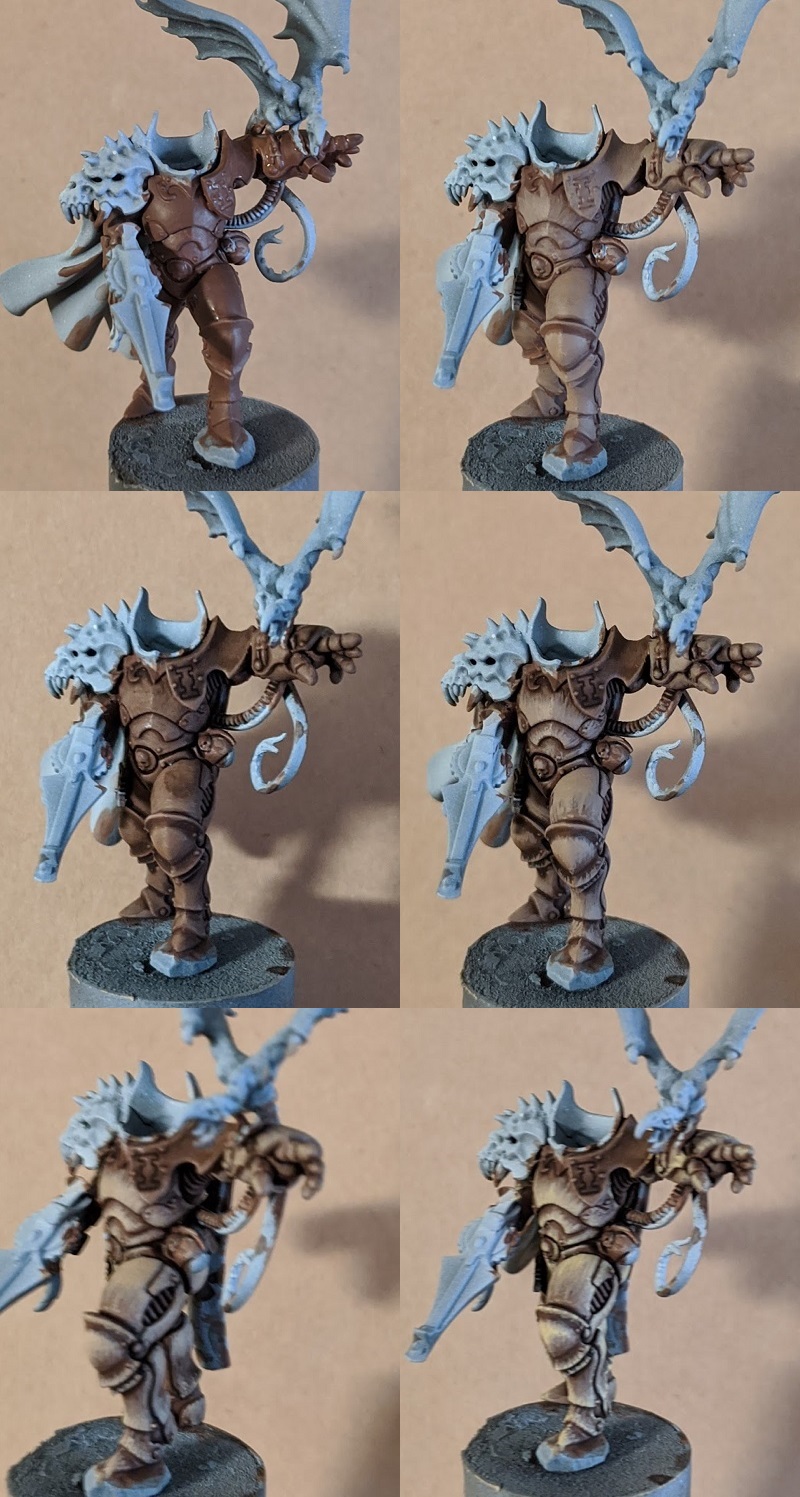
Since it’s the centerpiece of the model and scheme, as well as the bulk of the surface area of the model, I started with the bone armor. All throughout this process I worked in striped, feathered highlights, trying to give the armor as much texture and visual interest as possible. Doing the highlights this way was extremely painstaking and took hours, but I feel it was worth it for the main focus of the model.
- Basecoat of Gorthor Brown
- Striped highlight of Gorthor Brown with a small amount of VMC Dark Sand mixed in
- Wash of Agrax Earthshade
- Rehighlight with a similar mix to step 2, slightly less far in
- Add more Dark sand, Highlight further towards the edge
- With pure Dark Sand, dotted highlights along the edges of plates and striped down slightly into the plates in some areas. It’s important to maintain the texture with this last layer instead of doing a standard edge highlight, or you’ll lose a lot of the effect.
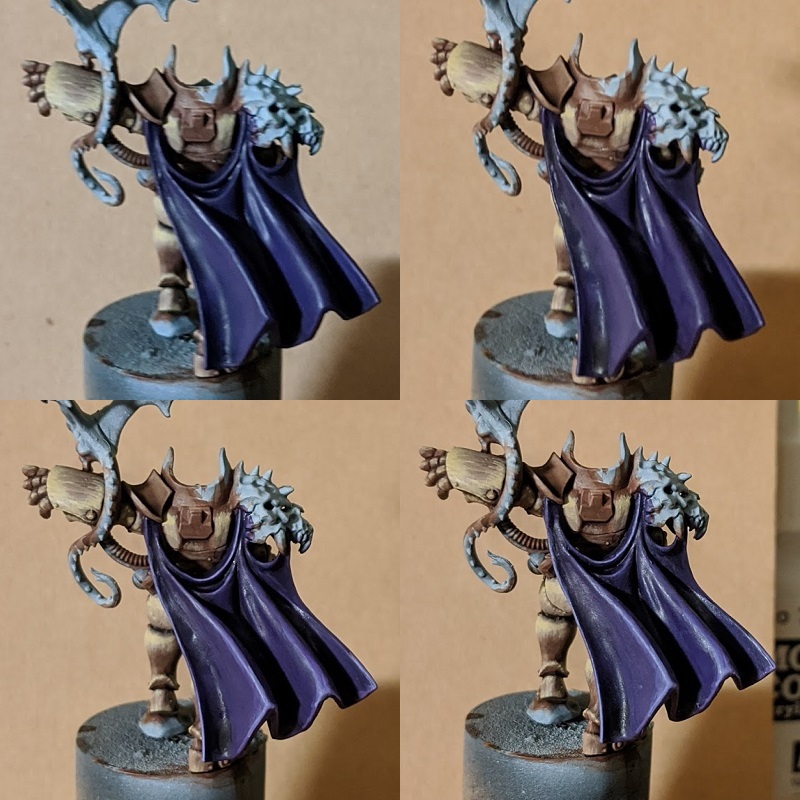
With that done, I moved on to the second biggest part of the model. Many thanks to Atom of the 13th Legion group in DC for his recipe. It makes an amazing purple with fairly little work.
- Basecoat Naggaroth Night
- Broad Highlight Phoenician Purple
- Wash of Druchii Violet
- Rehighlight with Phonecian Purple not quite as broadly
- Edge Highlight with Phoenician Purple mixed with a cool grey. I used VGC Wolf Grey but Celestra Grey or any cool grey would work fine as you’re mixing it. I did two highlights of successively lighter mixes to keep the cloth smooth.
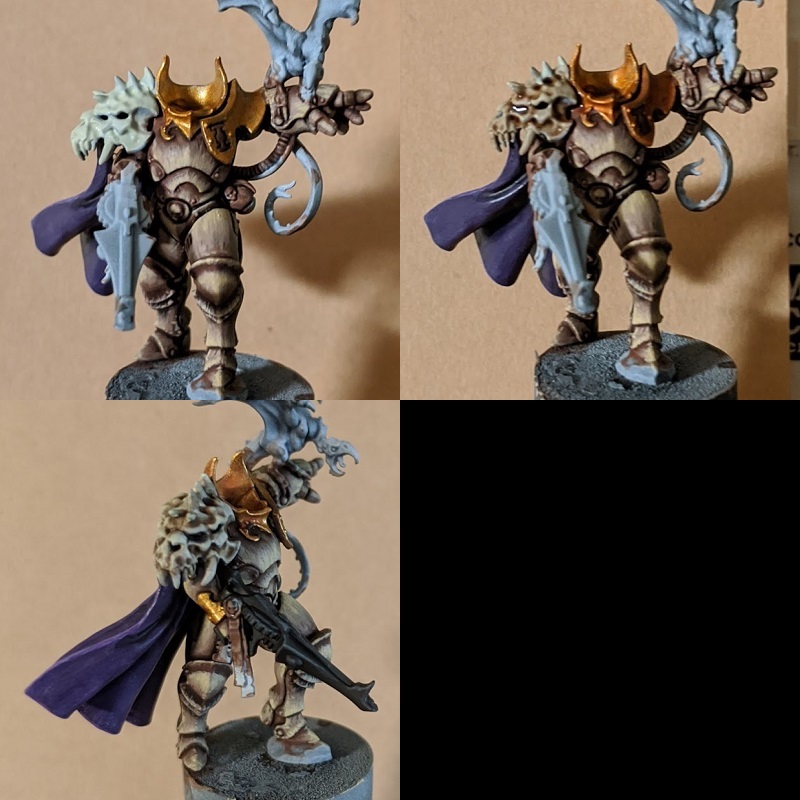
The Gold, Bone and Black are fairly simple. Of note is that apparently the spikes going up beside her head are part of the armor and I didn’t notice. Honestly I think it looks better this way, but that’s your choice to make.
- Gold: Retributor Armor washed with Reikland Fleshshade and rehighlighted with Retributor Armor. Usually I shade gold with Guilliman flesh, but I wanted to keep more of Retributor Armor’s yellow hue instead of tinting it more orange as I think yellow looks good with the bone and purple.
- Bone: I wanted to make sure that the skull didn’t blend into the armor, so I went with Deepkin Flesh as a base for a much cooler tone. A wash with Agrax Earthshade and a highlight with more Deepkin Flesh completes the look.
- Black: I didn’t do the black this way for any reason other than that I had deepkin flesh on my wet palette. Basecoat of VMC Black with a broad highlight of black mixed with a tiny bit of Deepkin Flesh and then a second edge highlight with slightly more. A few crevices were touched up with Nuln Oil.
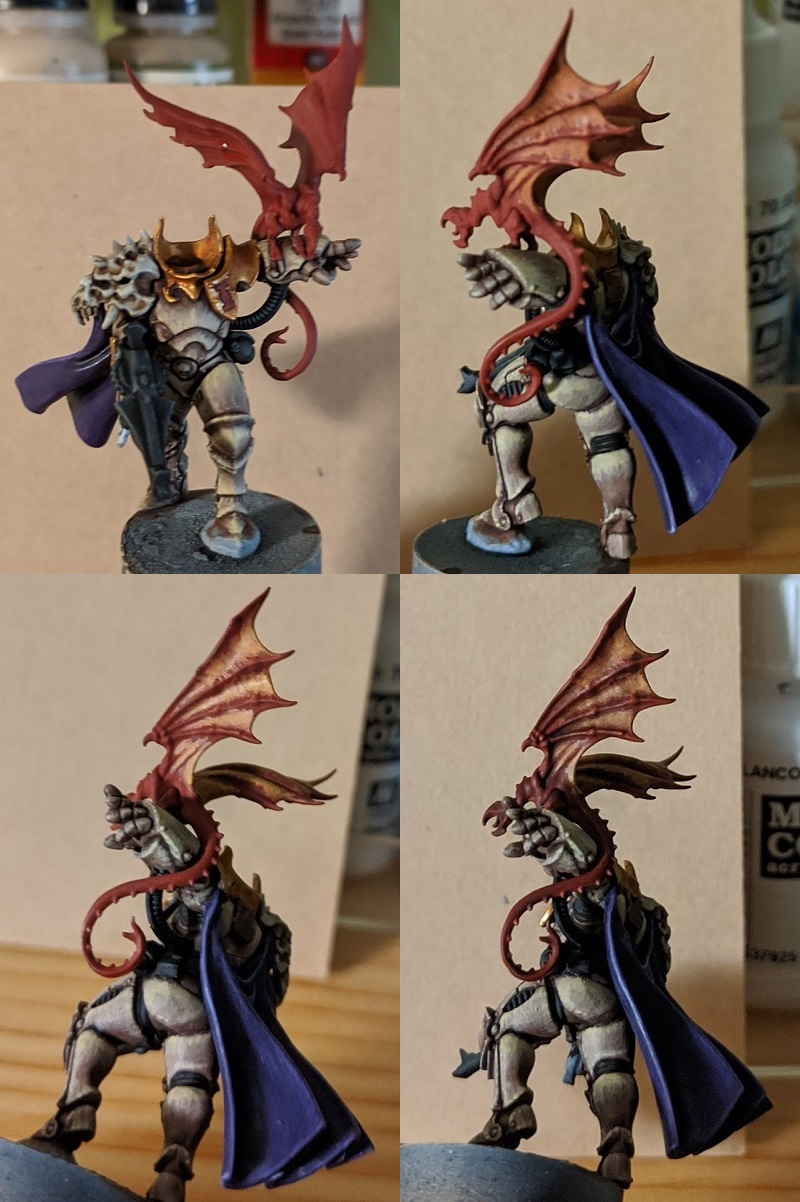
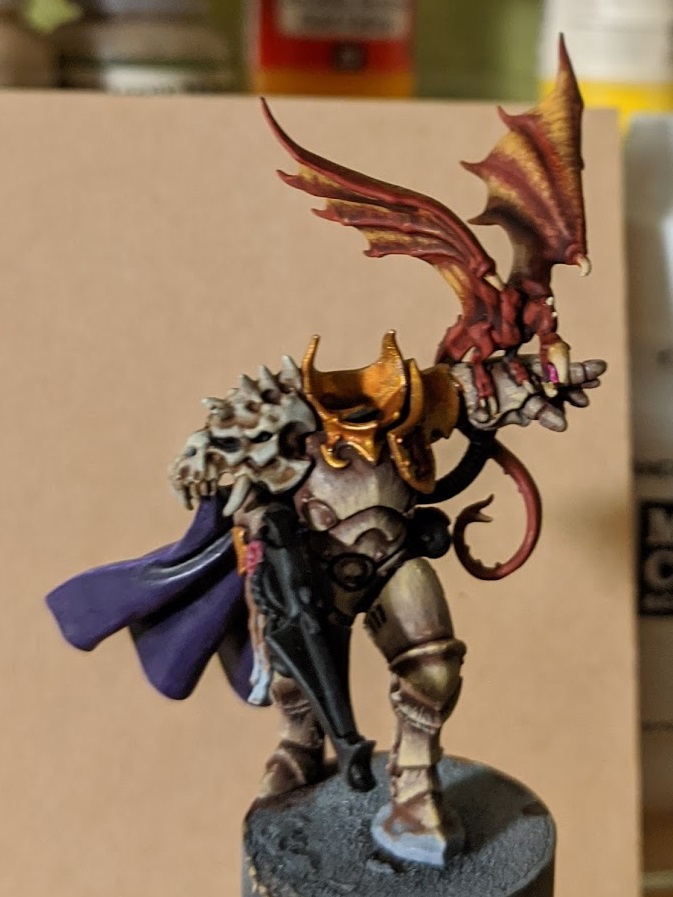
Now we’re on to some more interesting stuff. I was originally going to keep the green lizard, but on a whim I slathered some red onto it and fell in love.
- Basecoat VMC Cavalry Brown (Get the inquisition symbol now as well)
- Highlight the wings with stripes of a dark mix of VMC Cavalry Brown with VGC Filthy Brown
- Apply more stripes with much more Filthy Brown in the same mix. It’ll be a bit too bold and stark. That’s okay. The next step will tone it down.
- Wash the entire creature and inquisition symbol with Agrax Earthshade.
- Rehighlight both in the red areas with Cavalry Brown.
- Apply the tiniest stripes you can manage at the crests of the wing webbing with pure Filthy Brown.
The Talons and spikes were painted with pure VGC Filthy Brown then highlighted with VMC Dark Sand.
The tongue was painted with a mix of VMC Cavalry Brown and VGC Warlord Purple, then highlighted with pure Warlord Purple. I took the opportunity and used the same mix as a basecoat for the purity seal wax, and highlighted by mixing in a touch of white to the mix.
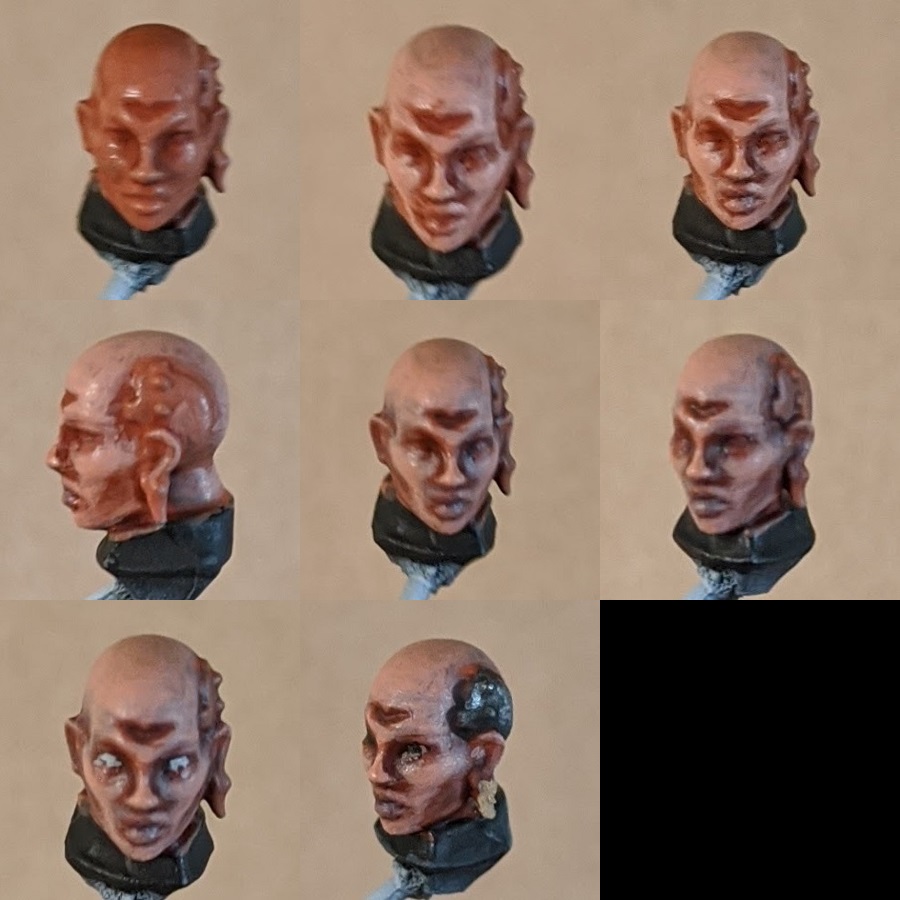
Her face is… well, it’s a bit of a challenge. I had to bring my A game to this one. If you’d like to brush up on skin, several excellent tutorials can be found here. I’ll go through the process I used here.
- Basecoat P3 Khardic Flesh and wash with Guilliman Flesh
- Highlight with a mix of Khardic flesh and VMC Pale Flesh
- Mix in more pale flesh, highlight again.
- Selective wash with Reikland Fleshshade to accentuate the features. I concentrated on the eyes, lips, and especially under her cheekbones to really sculpt the face shape. I actually looked at a few contouring tutorials for makeup to help me counteract the slightly… odd features her sculpt has.
- A faint, all over wash with a mix of VMC Dark Prussian Blue and Lahmian Medium. A Blue really helps add in some tonal variation to the skin.
- A very subtle highlight with the same mix as the last flesh color. Very subtle and delicate. Mostly just to reestablish features and catch the highest highlights of her face.
- Sigh heavily as you realize that her features are too subtle and delicate to look good if you don’t paint eyes. Get out your best detail brush and get some Ulthuan Grey on there.
- Dot on some black(or whatever dark color is on your palette) then drench your poor attempt at painting eyes in Reikland Fleshshade until it looks vaguely human. Artfully turn the head to the best looking angle for the ultra close up shot you need to take for a painting article.
- I guess also paint some Vallejo Mecha Air Dark Steel on the metal plate and wash it with Nuln Oil. The bone earring is VMC Dark Sand washed with Agrax Earthshade.
Then just paint and attach the backpack with methods we’ve already covered, and put some VMA Sand(Ivory) on the purity seal parchment, wash it with Agrax Earthshade, and you’re done.
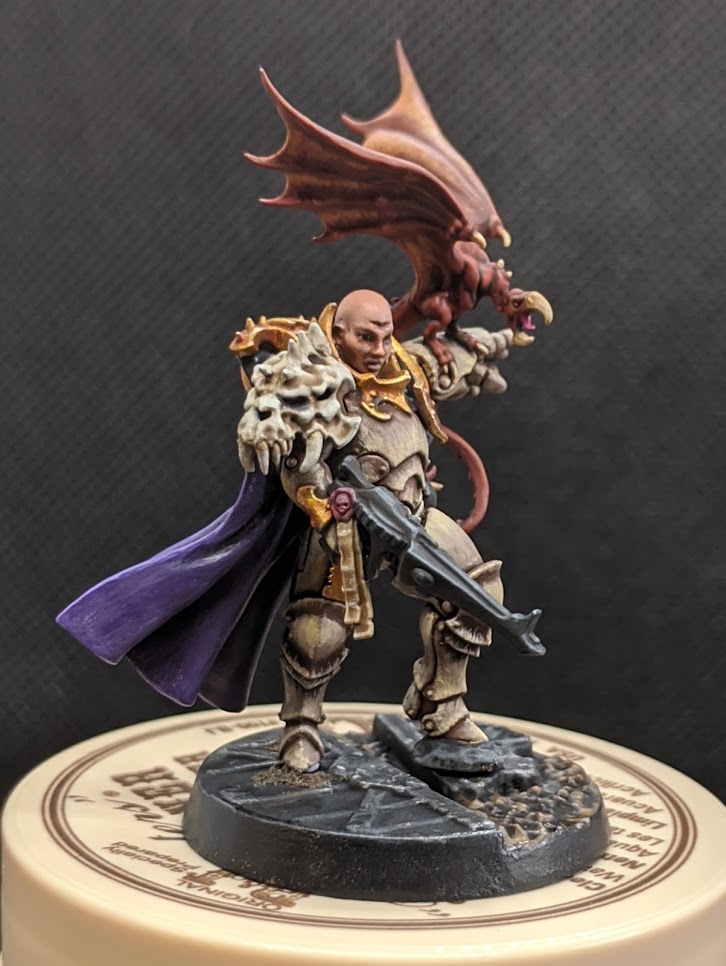
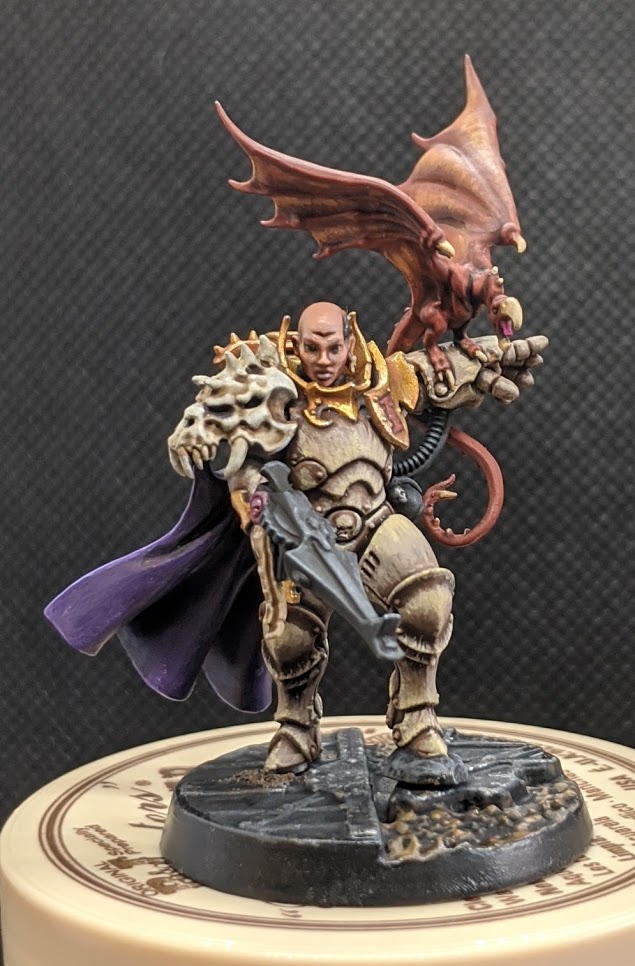
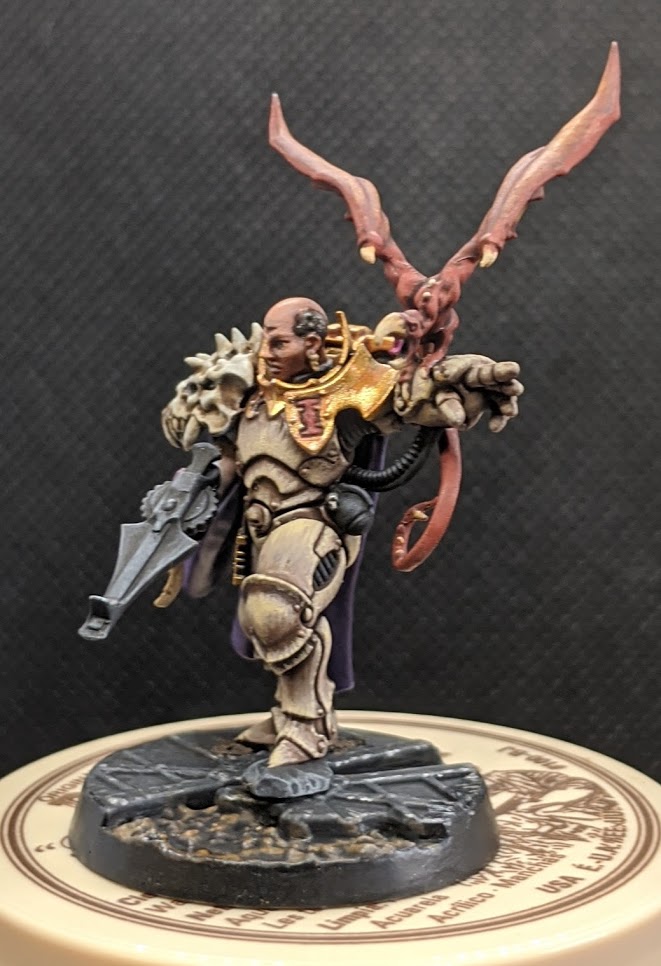


The only step left is to stick her to a base and post an absolutely egregious number of pictures in your article because of how proud you are of your tiny jewel like object of wonder.
Charlie B – Interrogator Nadiya Zelenko

Charlie B: For the sake of clarity I figured I’d follow the formula Felime used in the intro and show how it applies to this mini. Here goes:
Who are they?
As a pious and well educated up-spire snob from Hive Sejanus, Interrogator Zelenko is well acquainted with the finer things in life. She’s used to getting her way, although her confidence takes on a brittle quality as soon as she doesn’t feel entirely in control of a situation.
Her armour belonged to a slain Battle Sister and has been lovingly restored by the tech-adepts working for her patron Inquisitor. Not normally given to acts of manual labour, she makes a point of cleaning it herself as a form of devotional worship.
What’s her modus operandi?
As a noblewoman used to walking into a room and issuing imperious demands, Zelenko is relatively keen on operating overtly and requisitioning local assets to aid her. Acquiring a suit of power armour has done little to curb this instinct.
What can others tell by looking at your model?
Hopefully the regal blue cloak lining and clean white collar convey a certain amount of privilege and cleanliness, setting her far above the grim, spavined serfs you usually see accompanying Inquisition personnel. The conversion work – getting rid of the hat, stilettos and crossbow – hopefully indicate that she expects to be involved in a mission rather than standing at the back. If you want to read about how I did the conversion, I covered it over at the Beard Bunker.
What were the paint recipes?
As is often the case, I went for maximum effort on some bits of the paint job, then totally phoned it in on other parts. The metal in particular was pretty straightforward, consisting as it did of my now standard metal mix:
- Basecoat Army Painter Gunmetal
- Wash with Agrax Earthshade
- Wash with Nuln Oil Gloss
- Highlight with Army Painter Shining Silver
The blue tabard/lining was a more careful series of layers of various Coat d’Arms and Army Painter blues, layering up, glazing down, and layering up again. The browns, similarly, were a combination of Vallejo, Coat d’Arms and Army Painter colours. As per the advice given at the start of this article, you’ll notice that there’s really only one major colour on the mini (blue), and everything else is neutral. This also helps the red spot colour on her collar and hilt pop that much more.
Crab-stuffed Mushrooms – Inquisitor Fyodor Karamazov on the Throne of Judgement
Inquisitor Fyodor Karamazov on the Throne of Judgement
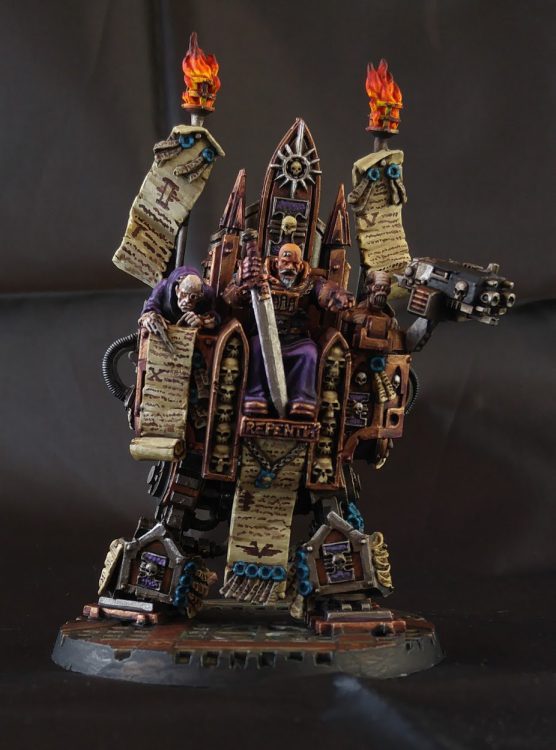
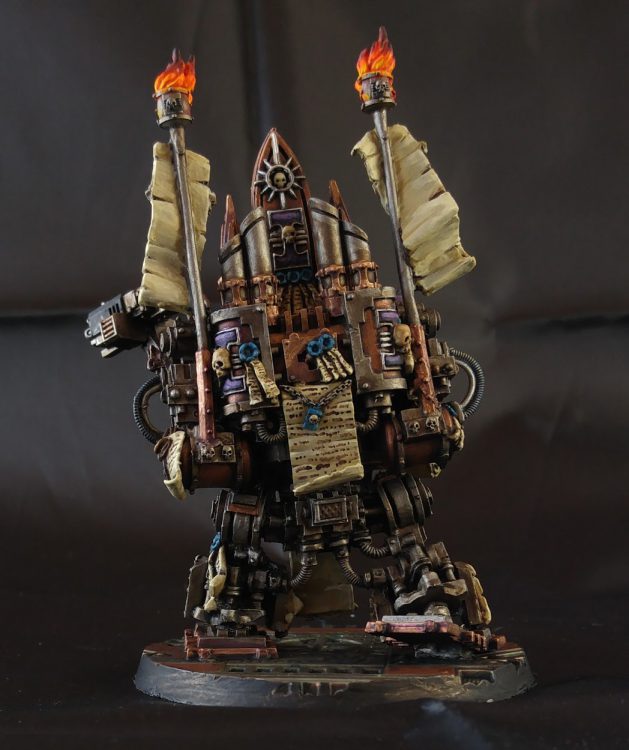
Who is he?
Lord Inquisitor striding around with a fanatical entourage, handing out death sentences from on high: Fyodor Karamazov is one bad-ass dude. If you like your Inquisitors in the classic style with a side of Exterminatus, Karamazov is your guy!
Inspiration
I painted Karamazov and his band of merry men around the release of Shadow Wars: Armageddon. This was off a wave of nostalgia: This was before the release of the revised Necromunda or Kill Team and GW’s first skirmish game in awhile. The idea of a fiery Inquisitor marching around on a throne with fanatics in tow was too good to resist. Like many GW games at the time, the rules were broken as hell, so I gave everyone Storm Bolters (I know… trust me I don’t do that, anymore).
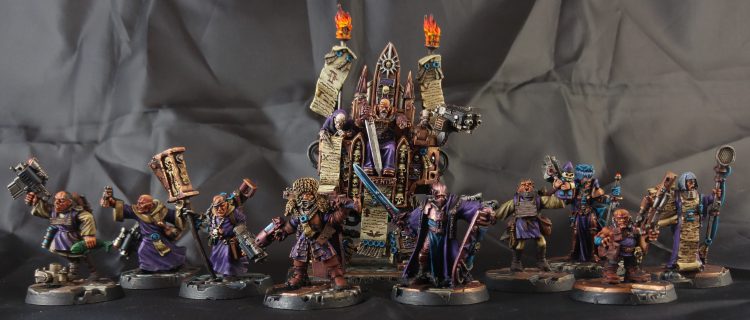
Paint Scheme
There weren’t a lot of Inquisitors painted in purple at the time and I was tired of painting black and red (popular colors for Inquisitors at the time). The image of a golden Throne of Judgment also seemed appealing.
Battle Ready
- The model was undercoated with Chaos Black
- The Gold on the Throne was painted with Balthasar Gold
- The Metal areas were painted with Leadbelcher
- The Robes and purple areas were painted with Xereus Purple (this may take several coats)
- Karamazov’s Face was basecoated with Bugman’s Glow
- The assistant’s Flesh was basecoated with Rakarth Flesh
- Once the base coats were done, the Robes, Gold, Metal, Flesh and Face areas were given a wash of Druchii Violet:
- Washing Gold with Purple is a brilliant cheat code. Try on a small area if you’re unsure.
- Note: Do not go too heavy on this wash or it won’t look like a shade if it dries. Don’t let it pool! You can always add another wash, later.
- The Scrolls were basecoated with Zandri Dust and washed with Agrax Earthshade
- The Flames were basecoated with Averland Sunset (this may take several layers).
Parade Ready
- The Gold was highlighted with Balthasar Gold
- The Metal was highlighted with Leadbelcher
- The Robes were highlighted with first Xereus Purple and then a 50/50 mix of Xereus Purple and Genestealer Purple
- The purity seals were basecoated with Stegadon Scale Green, then highlighted with Sotek Green and Temple Guard Blue
- The Inquisitor’s Face was highlighted with Bugman’s Glow, followed by a highlight of Cadian Fleshtone.
- The assistant’s Flesh was re-highlighted with Rakarth Flesh, followed by a highlight of 50/50 mix of Rakarth Flesh and Pallid Wych Flesh. It was then given a final highlight of Pallid Wych Flesh.
- The scrolls were re-highlighted with Zandri Dust, followed by highlights of Zandri Dust mixed 50/50 with Ushabti Bone. Final highlights were done with Ushabti Bone and Screaming Skull.
- The scroll and purity seal text was done with Rhinox Hide:
- Using a brush with a fine point, scriggle the brush up and down like the waves of a pulse rate on a chart to mimic the effect of text. The tighter your waves, the better the effect.
- The flames were re-painted with Yriel Yellow:
- Using Contrast Paints, the flames were given a coat of Iyanden Yellow
- Once dry, the flames were given a partial coat of Gryph-Hound Orange (leave some yellow showing at the base of the flames).
- Once dry, the flames were given a final, partial coat of Gryph-Hound Orange (leave some of the previous orange layer showing). This second coat should make the orange darker.
- The tips of the flames were given a drybrush of Abaddon Black.
- Note: Contrast Paints were not invented when I painted this model, but I would’ve used this method at the time if they were available.
Ryolnir – Inquisitor Coteaz
Inquisitor Coteaz is a model that I’ve wanted to painted since I was a teenager. I remember looking at this guy when he first dropped in a glorious clamshell packaging in awe of his awesome hammer and PSYBER EAGLE (I didn’t know it was called that at the time, but it looked cool so I liked it). I didn’t end up getting him back then, as I didn’t see a use for him with my Crimson Fists and money was in short supply. Nowadays, I waste money on all kinds of random Warhammer models, and now I can actually somewhat effectively use him alongside my boys in dark blue! He’d been sitting on my painting desk for a few weeks when Felime asked for Inquisitors, so I gave speed-painting him a try. I’m pretty happy with how he turned out – I tried a lot of techniques I don’t ever get to use on my Fists and I really want to push painters to try their hand at doing unique stuff with Inquisitors. They don’t have to match anybody – go nuts!
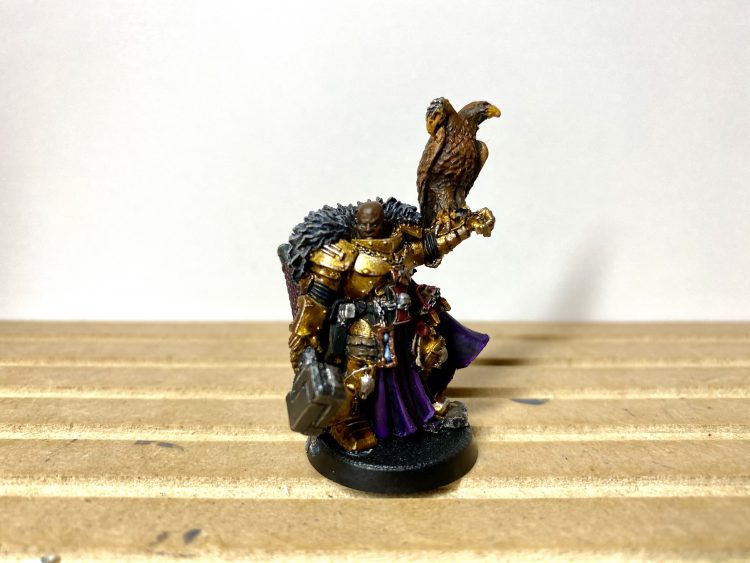
Who is Inquisitor Coteaz?: As an Inquisitor Lord of the Ordo Malleus, Coteaz’s specialty is hunting daemons. He wields a Master-crafted Nemesis Daemon hammer and it has a heft to it, perfect for splitting Bloodletters heads open (or a particular heretic who deems him to have broken the rules).
The Process: I started Coteaz with Stylnrez Black as I often do and let it cure for 24 hours (or two or three weeks, whichever works). Coteaz is Finecast nowadays (unless you score a metal one), so be sure to look for spare bits of resin in places you may not expect. These can be so egregious that I will sometimes look at photos of the model online just to make sure everything should actually be there. From there, I went to work! I am going to do my best to remember the entire process here as I went through a LOT of paints in a 2.5 hour speed paint session…
I then worked through a 3-step gold and a wash, in the following order – using less and less of the gold as I go through the process:
- Scale75 Viking Gold
- Scale75 Dwarven Gold
- Scale75 Elven Gold
- Citadel Colour Cryptek Armourshade Gloss
Once that was dry, I decided to paint his face and establish his skin tone. I knew I wanted him to have darker skin, so I started with a basecoat of Rhinox Hide. From there, I used Scale75 Bosh Chestnut thinner than the initial basecoat so that they wet blended a bit. A quick shade of Agrax Earthshade brought it to about where I wanted it.
Next, I did a fairly straight forward and fast pass on his cloak and loincloth. I wanted to paint something purple as I paint a lot of red cloth with Crimson Fists, so I went with the following, in order:
- Citadel Naggaroth Night (Basecoat)
- Citadel Xereus Purple (Highlight)
- Citadel Genestealer Purple (Second Highlight)
- Citadel Druchii Violet (Wash)
I was happy with how the model was coming together, so I wanted to move onto his cloak. From talking to Felime, I decided I wanted his cloak to be cooler than his warm golden armor, so I started off with Skavenblight Dinge. Since this was a chance to experiment, I then covered the upper half of the fur in Apothecary White (Contrast). I wasn’t liking the idea of shading it with Drakhenhof Nightshare so I took a gamble on it and ended up loving it. I then use Basillicanum Grey on the fur closest to his head to give it an even more shaded look. Finally, I drybrushed some Ulthuan Grey over the fur cloak to cool it down drastically and give it a cool highlighted look.
From there, it was all of his little details and goodies. The weapon side of his hammer and pommel is Vallejo Air Gunmetal, the handle is Khorne Red, as is his great big book and cool Inquisitor medallion (the book has an edge highlight of Wazdakka Red). All of the Silver is just Vallejo Air Color Silver, including the highlights on his golden armor and gunmetal hammer. His book’s pages and bandages on his leg are just Rakarth Flesh washed with Agrax Earthshade, nothing fancy. His hourglass is Balthazar Gold for the metallic and then The Fang as a basecoat, followed by a thinned down Fenrisian Grey and then a dot of Ulthuan Grey for some shine. Not shown here, but you should also hit it with a gloss varnish like ‘Ardcoat. I wasn’t happy with any version of his eyes, so I gave ol’ Coteaz some Baharroth Blue glowing eyes which worked out.
Now time for the bird… for the bird I was kind of losing my mind wetblending until I got a build up of brown/orange that I was happy with. For this, I just kept putting on layers of thin wet paint over thin wet paint, letting it dry to see if I was happy with it, and then another try. Here’s a list of what I worked into there:
- Scale75 Arbuckles Brown (Basecoat)
- Vallejo Model Color Chocolate Brown
- Scale75 Bosh Chestnut
- Scale75 Blackert Brown
- Vallejo Orange Brown
- Agrax Earthshade
- Reikland Fleshshade
From some frankenstein blending of all of this, I got a nice little birdy I’m real happy with. I painted the beaks (plural) Averland Sunset and washed them with Reikland Fleshshade to keep them nice and warm. The eyes are all Khorne Red with a dot of Wazdakka Red to give it a little highlight. That should be just about it for my Coteaz… well, I need to finish his base. And then take a nicer photo for this article… but if you are a better painter than I with a better camera, I bet this recipe would get you a really nice Inquisitor!
That wraps up our look at Inquisitors this week but if you have any questions or feedback, feel free to drop us a note in the comments below, or email us at contact@goonhammer.com.

